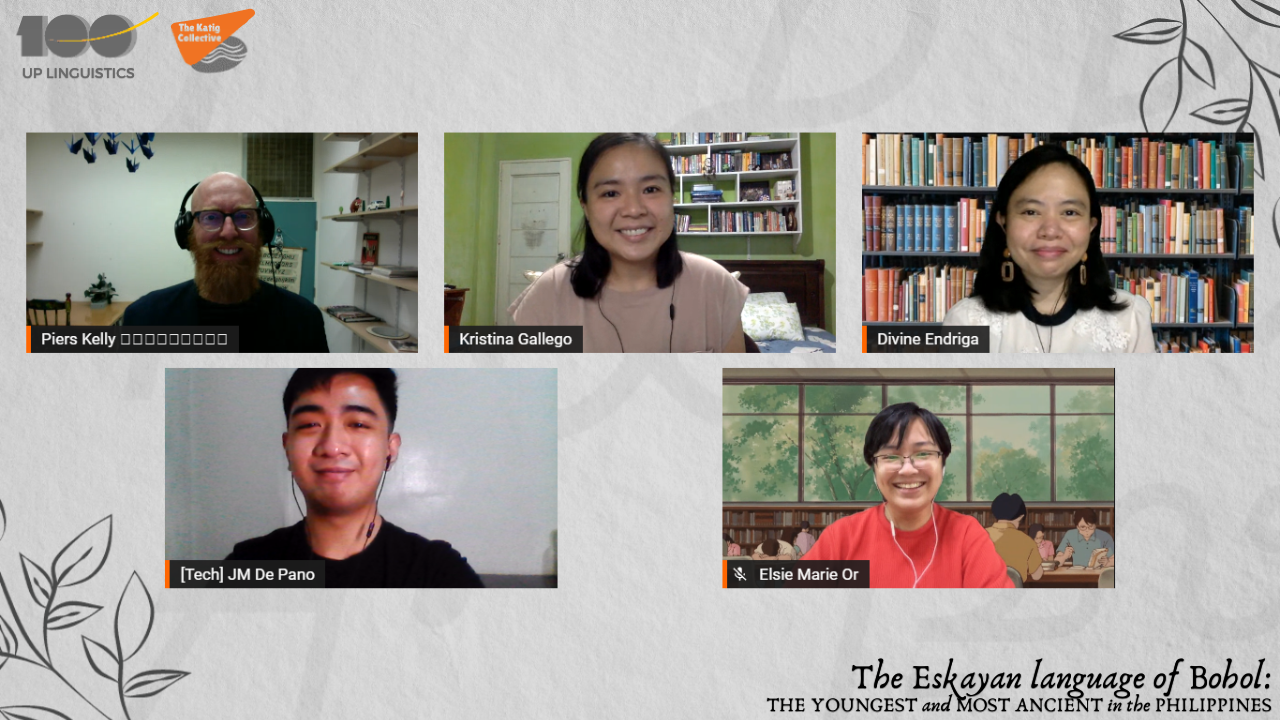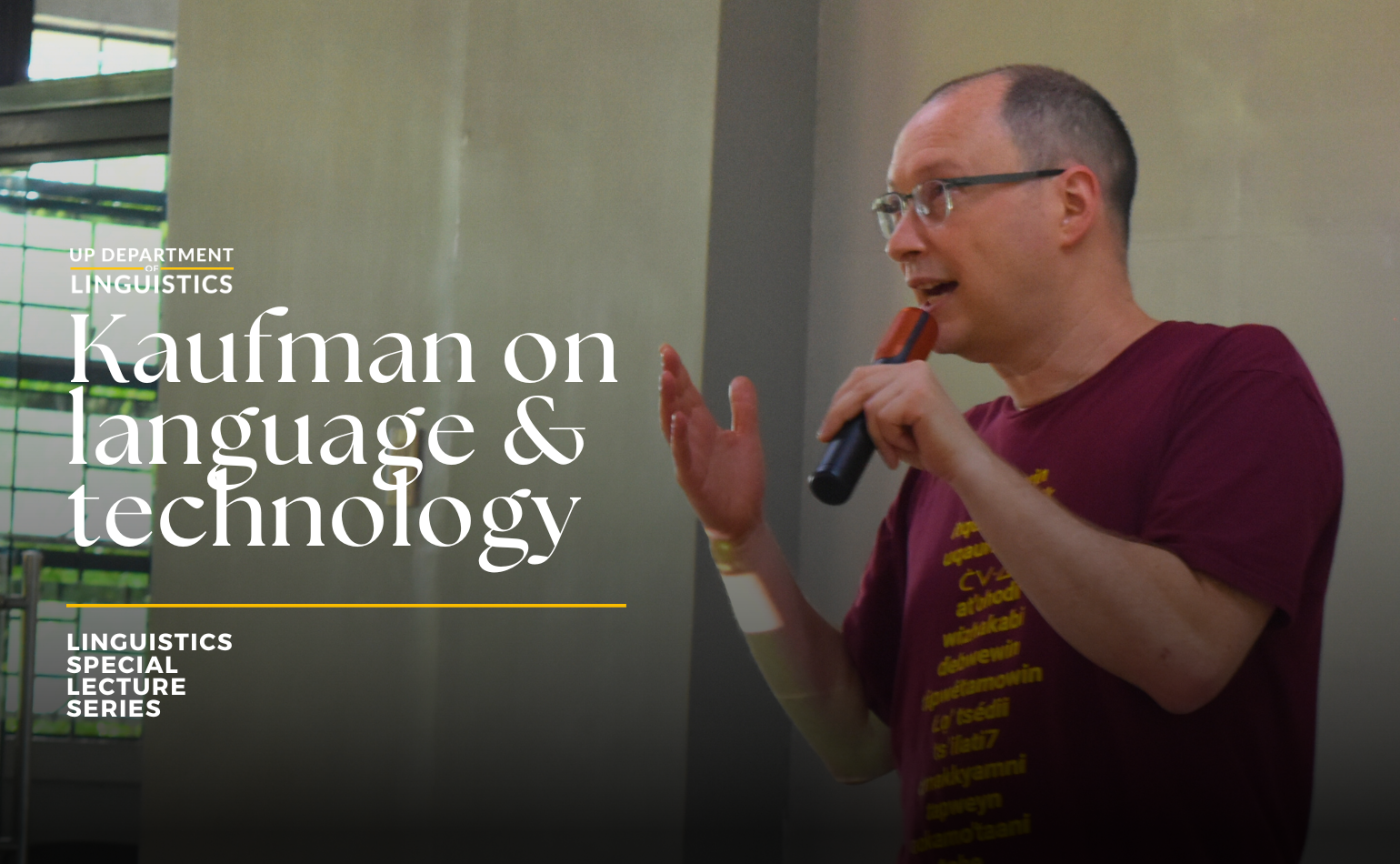
For the second installment of the 2022 Linguistics Special Lecture Series (LSLS), the Department together with The Katig Collective invited linguistic anthropologist Dr. Piers Kelly (University of New England) to talk about his research on Eskaya. The webinar, titled “The Eskayan language of Bohol: The youngest and most ancient in the Philippines,” was held on 27 October, and the recording of this lecture is available on the Department’s YouTube channel.
Dr. Kelly began his lecture by recounting how a man named Mariano Datahan wrote to Pres. Manuel L. Quezon in 1937–a time when discussions about the country’s national language was at its height. In Datahan’s letter, he wrote about a language spoken in a small village in Biabas in Bohol which they called “Bisayan Declarado.” This language, he described to the president, has its own writing system and was being taught to members of their community using learning materials that they had already developed. There is no record of Pres. Quezon or his then executive secretary, Jorge B. Vargas, ever accepting Datahan’s invitation of visiting their community to witness how they use and teach their language, but we do know that shortly after Vargas wrote a short reply to Datahan, Quezon’s Commonwealth administration and the then newly established Institute of National Language focused on promoting Tagalog as the basis of the country’s national language. The language spoken by a small community in Bohol that Datahan wrote about remained obscured from the wider public consciousness until decades later.
Kelly went on to explain that it was only in the 1980s that the public began to show interest in what is now known as Eskaya. The “discovery” of the “lost tribe” and its language resulted in their exoticization in the media. While some journalists and amateur scholars theorized that the Eskayan people might be the survivors of a pre-colonial Philippine civilization or even descendants Etruscans, some also accused the members of the Eskaya community of perpetuating a hoax and inventing their language to grab attention and receive patronage.
Kelly then emphasized that in pursuing this research, he was actually interested in learning about the story that the Eskayan language tells, and what this story means. He started by investigating from within, that is, by being acquainted with the language and the people, and continued by studying larger contexts. Approaching this matter as a linguist and as an anthropologist led to an understanding of the language’s structure, writing system, and domains of use, as well as its people’s ancestry and history. An objective and closer look at the Eskayan language also generated insights regarding its relationship to languages like Spanish and Boholano, the sacredness of their script, and the attitude of its users towards their language.
He ended his presentation by explaining the lecture’s title in connection with the Eskayan riddle Ang Sagbut ni Marilen, Kinadak-an sa Kalibutan, Kinagamyan sa yuta (‘Grass of Marilen, the biggest in the world, the smallest in the land’). Kelly said, “Just as the Filipino national language was created with a stroke of a pen, with authentic native words innovated to fill the gaps […], Eskayan was also declared into being. It’s the most ancient and most recent, the tiniest and yet most ambitious, the biggest in the world, the smallest in the land.”
After Kelly’s lecture, Asst. Prof. Maria Kristina Gallego provided a brief commentary, wherein she praised Kelly’s scholarship on the Eskayan language and people for highlighting “the complex interweaving of history and language;” the role of language ideologies and agentivity of the individual and the community when viewed through the lens of language contact and change; and how the story of Eskaya reflects the entanglements of language endangerment, social justice, and social change.
Questions asked during the open forum focused on the user population, beliefs about the Eskayan script, and the similarities and differences between Eskaya and other constructed languages. In response to an inquiry regarding the future of the Eskayan language, Kelly expressed both optimism and pessimism. He explained how Eskaya has the potential to grow because of its learners’ enthusiasm, but it is also in peril due to the more material issues that the community struggle with which are related to their resources, territorial disputes, and insurgencies.
Dr. Kelly’s book on the Eskayan people and their language is available for purchase at the Oxford University Press’ website.
Published by Patricia Anne Asuncion



